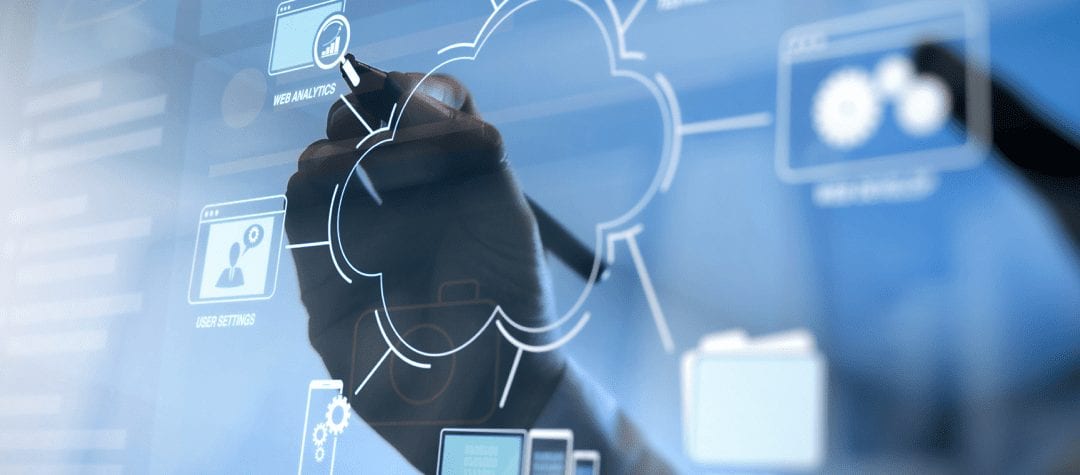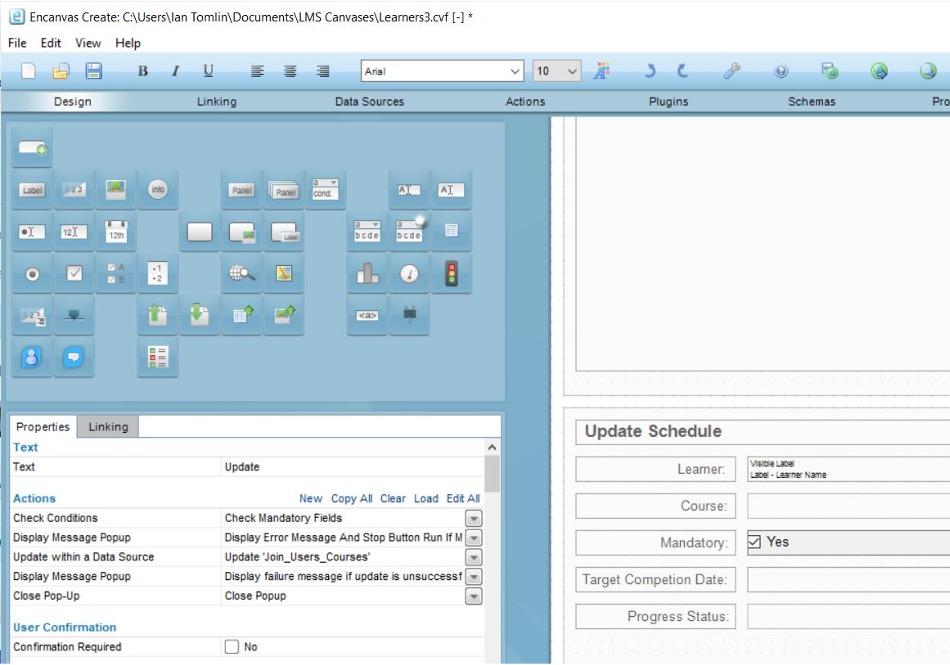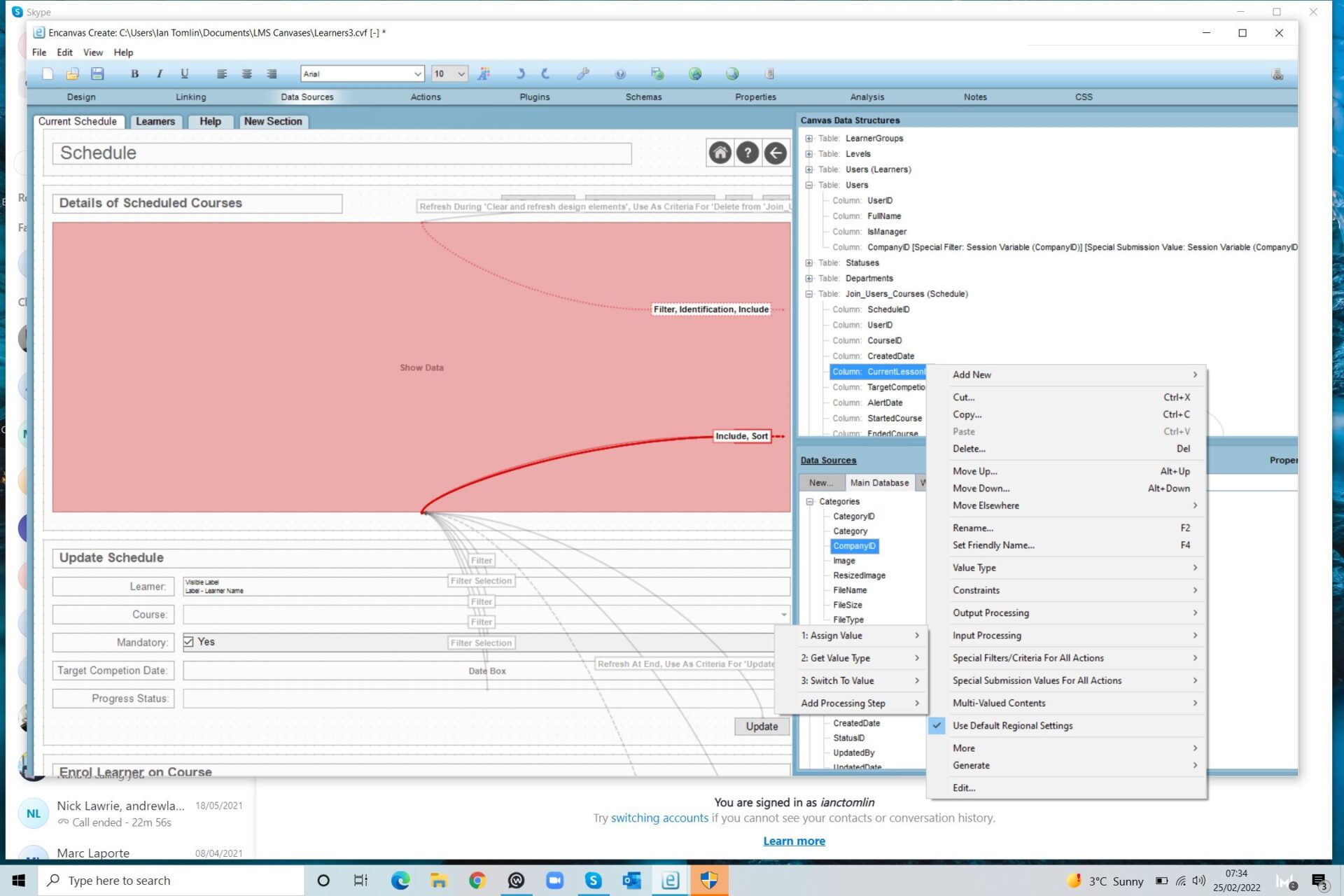EXPERIENCE ENCANVAS IN 60-MINUTES!
We're always happy to walk you through Encanvas no matter where you are in the world.

More details coming soon.

Discover Why aPaaS Technology Has Become The Secret Sauce of Cloud Computing
Written by Ian C. Tomlin | 12th January 2024
Read this article to get up-to-speed on applications Platform as a Service technology.
A Platform as a Service (PaaS) or application Platform as a Service (aPaaS) is the component of cloud computing services that facilitates the design, deployment and operation of potentially infinite numbers of apps, bots, digital documents and portals using no-code or low-code development methods. This reduces the complexity of building and maintaining a digital infrastructure whilst accelerating applications developments and improving business agility.
What was missing was the cloud tooling to enable Software-as-a-Service vendors (and enterprises themselves) to design, deploy and run applications. This is where enterprise aPaaS solutions come in.
Your aPaaS should support the full “Software Lifecycle” which allows cloud consumers to develop cloud services and applications (e.g. SaaS) directly on the PaaS cloud. Hence the difference between SaaS and PaaS is that SaaS only hosts completed cloud applications whereas PaaS offers a development platform that hosts both completed and in-progress cloud applications. This requires PaaS, in addition to supporting application hosting environment, to possess development infrastructure including programming environment, tools, configuration management, and so forth.
One of the challenges of porting applications to the cloud has been the risk of data loss. Data security has become an increasing concern to organizations because of their greater reliance on data to continue business operations. aPaaS platforms have to simplify how data is uploaded to the cloud, how it is cleansed, aggregated, and formed into new apps.
Additionally, the increased compliance risks of processing personally identifiable information (PII) have made organizations more concerned about the security risks of cloud-deployed applications. For this reason, being able to track what data is uploaded, who does it, where it goes to, etc. is essential for any aPaaS to be considered ‘enterprise grade.’

aPaaS platforms fulfil the business need to create custom apps. In a digital age, these need to be delivered fast, at low cost, and very low risk. aPaaS platforms began as low-code, then no-code and are now moving to a completely codeless format. Equipping organizations to design, deploy and run as many apps as they need, an aPaaS removes the barrier between IT and ‘the business.’
Coding and scripting is the biggest reason why software development has been traditionally unpredictable, costly and unable to produce best-fit software results. Encanvas uniquely automates coding and scripting. Our live wireframing approach means that business analysts can create the apps you need in workshops, working across the desk with users and stakeholders.
With a general recognition that business success is increasingly derived from the ability of an enterprise to master and leverage its data value, senior management teams are increasingly exploring ways to make sense of their operational performance through data. The ability to do away with data spaghetti; to re-use data – to harvest, cleanse, rationalize, and analyze it – has become a mission-critical need. A recent innovation that has added further data handling dexterity to Encanvas is HyperDrive. Launched in 2021, HyperDrive is an agnostic data plug-in enabler that turns any data type, DLL or plug-in into an integrated component of the Encanvas codeless design architecture.
With businesses using technology ever more to generate a competitive advantage in their market, it’s almost impossible to imagine a business model that doesn’t benefit from a great web app, or customer portal. This is causing organizations to become app factories, churning out custom apps as quickly as they can come up with ideas on how to improve customer experience, service new product lines, and cut back-office operating costs.
To orchestrate business processes, organizations are adopting aPaaS platforms to interface between:
1. Workers and computer systems (human-to-machine-interfacing-applications) and;
2. Computers (machine-to-machine-interfacing-applications).
Perhaps unsurprisingly, some processes require both human and machine interfaces. Additionally, Robotic Process Automation – the use of software robots to manage data flows and automate tedious tasks – has become a common characteristic of aPaaS platforms.
With a general recognition that business success is increasingly derived from the ability of an enterprise to master and leverage its data value, senior management teams are increasingly exploring ways to make sense of their operational performance through data. The ability to re-use data – to harvest, cleanse, rationalize, and analyze it – has become a mission-critical need.
An application Platform as a Service is the ecosystem used to orchestrate the end-to-end software development lifecycle (SDLC) for enterprise apps. While the focus of aPaaS is often towards speed of development, etc. arguably the most important selection factors come down to the hygiene issues of data integration, data security, deployability, scalability, data governance, and resilience.
The need for greater agility in IT systems, together with the rising influence of operational departments on enterprise software buying decisions, has led to the rise in application platforms that allow non-programmers to author applications. aPaaS platforms will generally adopt Low-Code, No-Code or sometimes even Codeless approaches to developing applications. In doing so, they reduce or remove the need to see or use programming code or script in the design, deployment and operational phases of the Software Development Cycle.
Encanvas is an enterprise software company that specializes in application Platform-as-a-Service (aPaaS) solutions and helping businesses to create above and beyond customer experiences. The platform removes the barrier between IT and the business. Coding and scripting is the biggest reason why software development has been traditionally unpredictable, costly and unable to produce best-fit software results. Encanvas uniquely automates coding and scripting. The software’s live wireframing approach means that business analysts can create the apps you need in workshops, working across the desk with users and stakeholders.


In most organizations a gap exists between inflexible Systems of Record – used to enforce good practice in common core back-office processes such as financial management, human resources, and customer relationship management – and demand for applications from departments, users, teams, customers, suppliers, and other stakeholders to support the fulfilment of a business model orchestration. A cloud aPaaS creates an umbrella across existing systems and fills the void in useful apps that workers, customers, suppliers, and other stakeholders want to use.
Now read:

Encanvas announces the launch of HyperDrive, giving app designers the means to embed practically any data source or digital component into enterprise processes.
OXFORD-UK, 29th April 2021 – ENCANVAS today announced the release of HyperDrive™, an enhancement to its enterprise app platform designed to give businesses an adaptive digital ecosystem to bridge between existing back-office tools and front-end websites to improve customer self-service transparency and experience.
This move towards use of digital technologies to bring differentiating value to customers means companies have become app innovation factories. Demand is fuelling a growing Rapid Applications Development tech industry and Low-Code app development solutions estimated to reach 1$46.4 billion by 2026.
HyperDrive™ is a new feature we are now including in ENCANVAS/4 as an optional upgrade. It’s a Universal Data Plug that means third-party code, script, apps or data sources can be embedded into ENCANVAS’s building block app ecosystem. What makes HyperDrive™ special lies in the way it allows app designers to incorporate new digital tech painlessly into their designs. Furthermore, any data received by HyperDrive™ can be pre-processed within ENCANVAS’s design environment bringing transparency and enormous control over consumed data.
<h3> ENCANVAS/4 with HyperDrive™ is on general release from 1st May 2021.</h3>
To request a trial, go to: https://www.encanvas.com/get-the-app/
Source:
1 – Report by KBV Research on the Global Low-Code Development Platform Market.
PRESS AND MEDIA CONTACT DETAILS:
Encanvas
Dove Cottage Offices, Abingdon Road, Marsham, Oxfordshire OX13 6NU, United KingdomTel: 02 3983 7001
info@encanvas.com
Media and Press Contacts:Newton Day Ltd
3rd Floor, 86-90 Paul Street, London, EC4a 2NE
Francesca Manleyfrancesca.manley@newtonday.uk
More Press Releases:
Data Integration is a term used to describe a collection of methods, tools and technologies used to connect more than one data source together, normally for the purpose of sharing, consuming or serving information.
Data integration must occur any time data needs to move from one system to another for any reason. These days, many processes are automated by computers and serviced by Internet of Things (IoT) devices. It’s not remarkable, therefore, that most businesses have many data integration challenges. There are remarkably few applications use cases that don’t demand the consumption or distribution of data to third-party data sources. For this reason, data integration is a key part of any software development.
Research conducted by Harvard Business Review (HBR) back in 2012 suggested that data integration represented something like a third of all software development project overheads.
The wide adoption of Software-as-a-Service applications over recent years has also done little to help enterprise data management challenges. Demands for data integration have exploded.
The statistics around SaaS are unnerving. According to a recent report by Blissfully, a New-York startup that operates a platform to track SaaS adoption, the average company with 200 to 500 employees uses about 123 Software-as-a-Service (SaaS) applications these days. For mid-sized companies, there are an average of 32 different billing owners for the SaaS subscriptions. On average, an employee uses eight SaaS applications!
There are a number of common challenges when it comes to re-using data from third-party systems. These include:
Not knowing what data exists, where it’s held, or how it’s held. Rarely do organizations support a detailed master data management taxonomy or record of data.
Complexity and integrity of file formats. Not all file formats structure data in a form that makes it easy to re-use. Sometimes, harvested data needs to be heavily cleansed and restructured in order to be useful.
Composite file-formats trap data. Some applications genres such as geospatial information systems (GIS) and Computer Aided Design (CAD) applications commonly use composite files that blend vector and binary data. This can make it difficult to extract data contained within the composite file structure.
Data quality. Often, when data is re-used from third-party systems, major data integrity and data quality issues can be exposed. This is because many applications used by organizations support data tables and rows in applications that aren’t used by the ‘customer’ organization. Only when data integrations are implemented in new applications are these data quality issues exposed.
Latency issues. Not all tables in all applications across an enterprise are up-to-date all of the time. For example, invoice data might not be accurate until the end of the month if billing cycles are delayed for batch processing. This can cause latency issues when harvesting or re-using data for new purposes as one system will lag behind another.
The absence of entity identifiers in data. Inconsistencies in the design of data structures in enterprise applications can strip them of useful entity identifiers to aid re-use. For example, when trying to re-use customer data across multiple applications, it may be that applications use alternative identifiers to identify ‘a customer’ – or worse still, no identifier at all!
Encanvas is an enterprise software company that specializes in helping businesses to create above and beyond customer experiences.
From Low Code to Codeless
Better than code-lite and low-code, we created the first no code (codeless) enterprise application platform to release creative minds from the torture of having to code or script applications.
Use Encanvas in your software development lifecycle to remove the barrier between IT and the business. Coding and scripting is the biggest reason why software development has been traditionally unpredictable, costly and unable to produce best-fit software results. Encanvas uniquely automates coding and scripting. Our live wireframing approach means that business analysts can create the apps you need in workshops, working across the desk with users and stakeholders.
When it comes to creating apps to create a data culture and orchestrate your business model, there’s no simpler way to instal and operate your enterprise software platform than AppFabric. Every application you create on AppFabric adds yet more data to your single-version-of-the-truth data insights. That’s because, we’ve designed AppFabric to create awesome enterprise apps that use a common data management substrate, so you can architect and implement an enterprise master data management plan.
Encanvas supplies a private-cloud Customer Data Platform that equips businesses with the means to harvest their customer and commercial data from all sources, cleanse and organize it, and provide tooling to leverage its fullest value in a secure, regulated way. We provide a retrofittable solution that bridges across existing data repositories and cleanses and organizes data to present a useful data source. Then it goes on to make data available 24×7 in a regulated way to authorized internal stakeholders and third parties to ensure adherence to data protection and FCA regulatory standards.
Encanvas Secure and Live (‘Secure&Live’) is a High-Productivity application Platform-as-a-Service. It’s an enterprise applications software platform that equips businesses with the tools they need to design, deploy applications at low cost. It achieves this by removing coding and scripting tasks and the overheads of programming applications. Unlike its rivals, Encanvas Secure&Live is completely codeless (not just Low-Code), so it removes the barriers between IT and the business. Today, you just need to know that it’s the fastest (and safest) way to design, deploy and operate enterprise applications.
Learn more by visiting www.encanvas.com.
Erica Tomlin is a senior consultant specializing in helping organizational leadership teams to grow by implementing enterprise software platforms that improve data visibility, process agility; and organizational learning – creating an enterprise that learns and adapts faster. She writes on subjects of change management, organizational design, rapid development applications software, and data science. She can be contacted via her LinkedIn profile.

Integration Platform-as-a-Service (ipaas) is a computing platform that equips enterprises with the ability to orchestrate machine-to-machine automations on-demand, usually employing codeless drag-and-drop tooling (most notable iPaaS examples include Encanvas, Redhat iPaaS and Mendix). Digital transformation projects often rely on a iPaaS technology ecosystem to design and deploy applications to automate back-office processes and streamline the customer experience.
Gartner defines iPaaS as – ‘ a suite of cloud services enabling development, execution, and governance of integration flows connecting any combination of on-premises and cloud-based processes, services, applications and data within individual or across multiple organizations. Gartner prefers to describe this market as ‘Integration software as a service (iSaaS)’ – packages that are cloud-based integration tools providing either prepackaged or easily configurable integration flows aimed at helping non-IT business users and even consumers to address simple application and data integration issues.
Against a background of digital transformations, IT leaders need to focus on revamping enterprise integration strategy, which will invariably involve the aggregation and management of data from a variety of computing platforms and applications. iPaaS solutions supply the necessary glue ware to easily design, deploy and operate machine-to-machine workflows. They offer simple deployment and operational flexibility at a lower cost of ownership to satisfy a broad range of data integration needs. Integration specialists like NDMC Consulting use iPaaS integration platforms to implement digital transformations in enterprise-scale businesses.
The term iPaaS should not be confused with independent Software as a Service (iSaaS) solutions. While a platform-as-a-service provisions the tooling needed to design, deploy and use applications, software-as-a-service solutions are the apps themselves, provisioned by software companies as a turnkey solution to fit a specific use case, task or automation.
An important business driver for integration services comes from the desire of executives to harvest data from across their enterprise in order to make informed decisions. The drive towards a data-driven culture demands that systems connect to one another. The integrity of data executives review, is a major sticking point.
A survey of 442 business executives around the world by Harvard Business Review found that corporate decision-makers have major concerns about access to, availability of, and quality of internal and outside data. The result is reduced confidence in their decision-making ability.
Moreover, nearly half of the global respondents said their lack of confidence stems from a lack of information or easy access to data. The findings are puzzling given the emergence of big data techniques, the proliferation of global networks and the sheer processing power contained even in mobile devices.
One reason for the disconnect between big data and decision-making, the Harvard researchers found, is that “silos of data, typically imprisoned in customer, financial, or production systems, are frequently inaccessible by individuals outside the functional group.”
In this regard:
Generally, iPaaS solutions are “deployment-model-agnostic” and offer integration capabilities irrespective of how the enterprise computing architecture has been modelled – be it on-premises and cloud deployments or as containerized middleware.
While iPaaS solutions are the most popular because of their rapid deployment, many businesses will choose instead to build their own hybrid solutions by bringing together a mix of third-party products and crafting their own solutions to mimic the capabilities that iPaaS solutions deliver out-of-the-box.
Cloud-based hybrid integration (and hybrid integration platforms like ipaas) is expected to account for at least 50 percent of new spend on middleware by the end of 2019 (not counting upgrades or license renewals on existing on-premise middleware).
In a recent Ovum report, Ovum Decision Matrix: Selecting a Cloud Platform for Hybrid Integration Vendor, 2019–20, they suggest the global iPaaS market will grow at a 59.7 per cent compound annual growth rate (CAGR) between 2018 and 2023, to US$10.2 billion.
Key capabilities of iPaaS solutions
Buyers would expect any iPaaS solution to offer:
The key characteristics of a hybrid integration platform include:
In addition to encanvas, iPaaS examples include:
Boomi
SnapLogic
TIBCO Software Inc.
Informatica Corporation
MuleSoft, Inc.
Fujitsu Ltd.
IBM Corporation
Microsoft Corp.
Moskitos
Adaptris
Oracle Corporation
Red Hat Inc.
Capgemini SE
SAP SE
Dell Inc.
Seeburger
WS02
Axway
Encanvas is an enterprise software company that specializes in iPaaS solutions and helping businesses to create above and beyond customer experiences.
From Low Code to Codeless
Better than code-lite and low-code, we created the first no code (codeless) enterprise application platform to release creative minds from the torture of having to code or script applications.
Use Encanvas in your software development lifecycle to remove the barrier between IT and the business. Coding and scripting is the biggest reason why software development has been traditionally unpredictable, costly and unable to produce best-fit software results. Encanvas uniquely automates coding and scripting. Our live wireframing approach means that business analysts can create the apps you need in workshops, working across the desk with users and stakeholders.
When it comes to creating apps to create a data culture and orchestrate your business model, there’s no simpler way to instal and operate your enterprise software platform than AppFabric. Every application you create on AppFabric adds yet more data to your single-version-of-the-truth data insights. That’s because, we’ve designed AppFabric to create awesome enterprise apps that use a common data management substrate, so you can architect and implement an enterprise master data management plan.
Encanvas supplies a private-cloud Customer Data Platform that equips businesses with the means to harvest their customer and commercial data from all sources, cleanse and organize it, and provide tooling to leverage its fullest value in a secure, regulated way. We provide a retrofittable solution that bridges across existing data repositories and cleanses and organizes data to present a useful data source. Then it goes on to make data available 24×7 in a regulated way to authorized internal stakeholders and third parties to ensure adherence to data protection and FCA regulatory standards.
Encanvas Secure and Live (‘Secure&Live’) is a High-Productivity application Platform-as-a-Service. It’s an enterprise applications software platform that equips businesses with the tools they need to design, deploy applications at low cost. It achieves this by removing coding and scripting tasks and the overheads of programming applications. Unlike its rivals, Encanvas Secure&Live is completely codeless (not just Low-Code), so it removes the barriers between IT and the business. Today, you just need to know that it’s the fastest (and safest) way to design, deploy and operate enterprise applications.
Learn more by visiting www.encanvas.com.
Erica Tomlin is a senior consultant specializing in helping organizational leadership teams to grow by implementing enterprise software platforms that improve data visibility, process agility; and organizational learning – creating an enterprise that learns and adapts faster. She writes on subjects of change management, organizational design, rapid development applications software, and data science. She can be contacted via her LinkedIn profile.